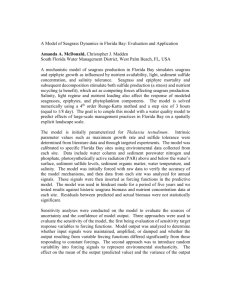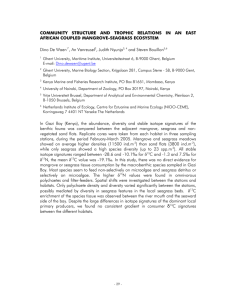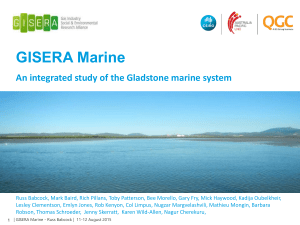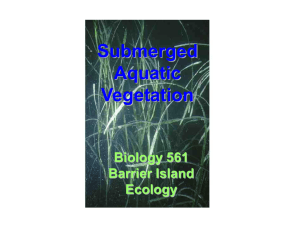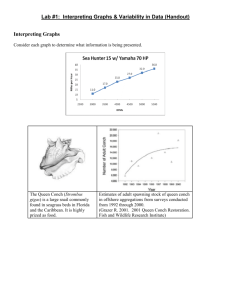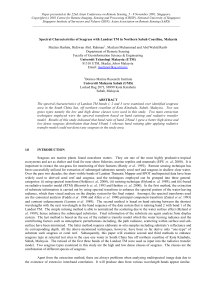Trends in Seagrass Abundance and Density, and Water Quality near the
advertisement
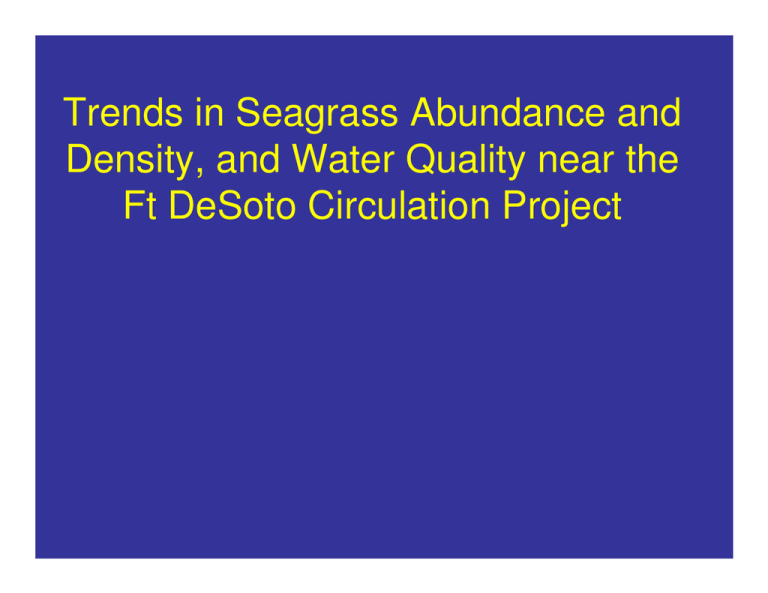
Trends in Seagrass Abundance and Density, and Water Quality near the Ft DeSoto Circulation Project Ft DeSoto 1942 and Future Bridge Location Ft DeSotoBridge Location Circulation Re-established at Bridge Circulation Re-established at Bridge Possible Benefits to Nearby Seagrass Boca Ciega Bay Transects General Description • BCB-10 is located in South Mullet Key Bayou. • The transect extends northeast 150m from the mangrove shoreline towards the boat channel. • The depth ranged from 30cm-140cm. • The sediment composition was sandy mud. • The seagrass bed was a mixture of Halodule and Thalassia. • The condition of the seagrass varied from fair to good . • Green marks - coverage • Red marks – density and wq Seagrass Species 175 Seagrass Species 175 170 169 160 151 150 140 130 120 110 102 100 90 80 78 75 70 60 Seagrass Species 170 169 160 151 150 140 130 120 110 102 100 90 80 78 75 Halophila 70 Syringodium Thalassia 60 Halodule 50 Thalassia Halophila 50 Syringodium 25 15 3 2 1 0 B r a u n -B la n q u e t R a n k Halodule 25 15 3 2 1 0 B r a u n - B la n q u e t R a n k Seagrass Coverage – Braun Blanquet 1999 5 4 3 2 1 0 2000 5 4 3 2 1 0 175 175 170 169 160 151 150 140 130 120 110 102 100 90 80 78 75 70 Seagrass Species 170 169 160 151 150 140 130 120 110 102 100 90 80 78 75 Halophila 70 Halophila 60 Thalassia 50 Syringodium 60 Syringodium Thalassia 25 15 3 2 1 0 B r a u n -B la n q u e t R a n k Halodule 50 Halodule 25 15 3 2 1 0 B r a u n - B la n q u e t R a n k Seagrass Coverage – Braun Blanquet 2001 5 4 3 2 1 0 Seagrass Species 2002 5 4 3 2 1 0 175 175 170 169 160 151 150 140 130 120 110 102 100 90 80 78 75 70 Seagrass Species 170 169 160 151 150 140 130 120 110 102 100 90 80 78 75 Halophila 70 Halophila 60 Thalassia 50 Syringodium 60 Syringodium Thalassia 25 15 3 2 1 0 B r a u n - B la n q u e t R a n k Halodule 50 Halodule 25 15 3 2 1 0 B r a u n -B la n q u e t R a n k Seagrass Coverage – Braun Blanquet 2003 5 4 3 2 1 0 Seagrass Species 2004 5 4 3 2 1 0 Seagrass Coverage – Braun Blanquet B r a u n - B la n q u e t R a n k Seagrass Species Halodule Syringodium Thalassia Halophila 2005 5 4 3 2 B r a u n - B la n q u e t R a n k Seagrass Species Halodule Syringodium Thalassia Halophila 175 170 169 160 151 150 140 130 120 110 102 100 90 80 78 75 70 60 50 25 15 3 2 1 0 1 0 2006 Distance Along Transect (m) 175 170 169 160 151 150 140 130 120 110 102 100 90 80 78 75 70 60 50 25 15 3 2 1 0 5 4 3 2 1 0 Canopy Height BCB-10 Canopy Height 60 Halodule Canopy Height (cm) 50 Thalassia 40 30 20 10 0 1996 1998 2000 2002 Year 2004 2006 2008 Shoot Density, Mid-bed and Edge of Bed BCB-10 Shoot Density 2000 Halodule 1800 Thalassia Mean Density per m2 1600 1400 1200 1000 800 600 400 200 0 1996 1998 2000 2002 Year 2004 2006 2008 Possible Water Quality Benefits Chlorophyll-a Trend at BCB-10 Transect Average Chlorophyll-a Along Transect BCB 10 Chlorophyll-a Pg/L 30 25 20 15 10 5 0 10/28/95 7/24/98 4/19/01 1/14/04 Date 10/10/06 7/6/09 Mullet Key Bayou Chlorophyll-a Trend Chlorophyll-a in Mullet Bayou North of Transect BCB 10 Chlorophyll-a mg/L 30 25 20 15 10 5 0 10/28/95 7/24/98 4/19/01 Date 1/14/04 10/10/06 7/6/09 Summary • • • • • • • • • • • • BCB-10 varied in species composition and abundance while maintaining a stable seagrass bed. Data indicate that the edge of bed is consistent at 150m throughout the monitoring program. In 1998 the prominent seagrass was Halodule. In 1999-2000, Thalassia increased in abundance becoming the prominent seagrass. By 2001, Halodule and Thalassia were both prominent species along the transect. The abundance of both seagrasses decreased in 2002, and then increased slightly through 2003-2004. The abundance of the Halodule increased drastically in 2005-2006. In November 2004, the Fort De Soto Recirculation Project restored the connection between the east and west side of the causeway. Improved circulation may have contributed to the increase in seagrass abundance along the transect. The epibiont density was light to heavy consisting of attached algae, polycheates, and barnacles. The canopy height ranged from 15cm-35cm with Thalassia consistently higher than the Halodule. Shoot density for Thalassia ranged from 25-200 shoots (per m2) with a decreasing density trend. Shoot density for Halodule ranged from 25-1600 shoots (per m2) with a doubling in density from 2004-2006.

